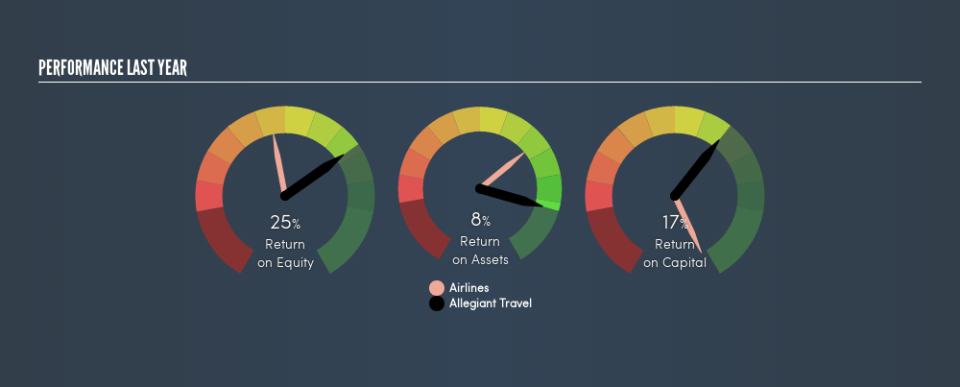A Close Look At Allegiant Travel Company’s (NASDAQ:ALGT) 17% ROCE

Want to participate in a short research study? Help shape the future of investing tools and receive a $20 prize!
Today we are going to look at Allegiant Travel Company (NASDAQ:ALGT) to see whether it might be an attractive investment prospect. To be precise, we’ll consider its Return On Capital Employed (ROCE), as that will inform our view of the quality of the business.
First, we’ll go over how we calculate ROCE. Then we’ll compare its ROCE to similar companies. Finally, we’ll look at how its current liabilities affect its ROCE.
Understanding Return On Capital Employed (ROCE)
ROCE is a metric for evaluating how much pre-tax income (in percentage terms) a company earns on the capital invested in its business. Generally speaking a higher ROCE is better. In brief, it is a useful tool, but it is not without drawbacks. Renowned investment researcher Michael Mauboussin has suggested that a high ROCE can indicate that ‘one dollar invested in the company generates value of more than one dollar’.
So, How Do We Calculate ROCE?
The formula for calculating the return on capital employed is:
Return on Capital Employed = Earnings Before Interest and Tax (EBIT) ÷ (Total Assets – Current Liabilities)
Or for Allegiant Travel:
0.17 = US$243m ÷ (US$2.5b – US$1.0b) (Based on the trailing twelve months to December 2018.)
Therefore, Allegiant Travel has an ROCE of 17%.
Check out our latest analysis for Allegiant Travel
Does Allegiant Travel Have A Good ROCE?
One way to assess ROCE is to compare similar companies. Using our data, we find that Allegiant Travel’s ROCE is meaningfully better than the 11% average in the Airlines industry. We consider this a positive sign, because it suggests it uses capital more efficiently than similar companies. Independently of how Allegiant Travel compares to its industry, its ROCE in absolute terms appears decent, and the company may be worthy of closer investigation.
As we can see, Allegiant Travel currently has an ROCE of 17%, less than the 40% it reported 3 years ago. So investors might consider if it has had issues recently.
When considering ROCE, bear in mind that it reflects the past and does not necessarily predict the future. ROCE can be deceptive for cyclical businesses, as returns can look incredible in boom times, and terribly low in downturns. This is because ROCE only looks at one year, instead of considering returns across a whole cycle. What happens in the future is pretty important for investors, so we have prepared a free report on analyst forecasts for Allegiant Travel.
Allegiant Travel’s Current Liabilities And Their Impact On Its ROCE
Current liabilities are short term bills and invoices that need to be paid in 12 months or less. Due to the way the ROCE equation works, having large bills due in the near term can make it look as though a company has less capital employed, and thus a higher ROCE than usual. To counteract this, we check if a company has high current liabilities, relative to its total assets.
Allegiant Travel has total liabilities of US$1.0b and total assets of US$2.5b. Therefore its current liabilities are equivalent to approximately 41% of its total assets. Allegiant Travel has a medium level of current liabilities, which would boost the ROCE.
The Bottom Line On Allegiant Travel’s ROCE
While its ROCE looks good, it’s worth remembering that the current liabilities are making the business look better. But note: Allegiant Travel may not be the best stock to buy. So take a peek at this free list of interesting companies with strong recent earnings growth (and a P/E ratio below 20).
If you are like me, then you will not want to miss this free list of growing companies that insiders are buying.
We aim to bring you long-term focused research analysis driven by fundamental data. Note that our analysis may not factor in the latest price-sensitive company announcements or qualitative material.
If you spot an error that warrants correction, please contact the editor at editorial-team@simplywallst.com. This article by Simply Wall St is general in nature. It does not constitute a recommendation to buy or sell any stock, and does not take account of your objectives, or your financial situation. Simply Wall St has no position in the stocks mentioned. Thank you for reading.

